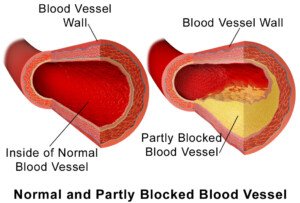Can a zero calcium score be a benefit to or help offset the beginning of heart failure if your ejection fraction is 50%?
“For background, calcium scoring is a diagnostic test used to help identify patients who may have coronary artery disease, or CAD, which are essentially coronary blockages,” says Beth Davidson, DNP, past president of the American Association of Heart Failure Nurses.
“CAD is a risk factor for the development of heart failure.”
In coronary artery disease, in which plaque builds up inside the arteries and narrows blood flow to the heart, the heart then suffers from insufficient levels of oxygen.

BruceBlaus
Over time this can weaken the heart – which is a muscle that contracts.
A heart that contracts weakly is a heart in failure.
A calcium scoring is done with a CT scan and takes about 15 minutes.
“A ‘zero’ score means that no calcium was seen in the heart – a patient is then at low risk for blockages/CAD, thus reducing their risk of HF due to this particular cause,” says Davidson.
So if you have a calcium score of zero and an ejection fraction of 50% — or higher, for that matter – then you can cross off one – just one – risk factor for future chronic heart failure.
This doesn’t let you off the hook, though.
While old age is a risk factor for CHF, and in theory, we’d all develop CHF if we lived long enough, there are other risks or causative agents that cause heart failure in younger individuals.
You may have clean arteries now, as determined by calcium scoring and even a cardiac stress test, but this doesn’t give you the green light to ignore other modifiable risk factors such as the following:
• Obesity. The more severe the obesity (morbidly and super morbidly), the greater the harm of excess fat to the heart.
• Hypertension. High blood pressure that goes untreated damages the heart, causing it to change shape, making it pump weakly.
• Smoking and heavy drinking. Smoke and liquor damage the heart. Period.
• Lack of exercise. The heart, being a muscle, benefits from consistent, structured exercise regimes.
Though cardiac muscle isn’t the same as skeletal muscle, its efficiency can be improved with aerobic and strength exercise.
• SAD: standard American diet. The SAD is made of heavily processed, high-sodium foods.
A pervasive ingredient in many foods such as bread crumbs is trans fats, which is toxic to the heart.
• Sleep apnea. Many people have obstructive sleep apnea and don’t know it.
Though obesity is a major cause, it can occur in thin people, since OSA has many causes.
Untreated sleep apnea causes strain to the heart which can change its shape, making it pump poorly.
The aforementioned list of CHF risks is not complete. But it’s enough to clearly show that you should not get too secure about a zero calcium score if you’re concerned about future heart failure.
 Beth Davidson is a nurse practitioner specializing in heart failure, based in Nashville, TN, and former director of the Heart Failure Disease Management Program at TriStar Centennial Medical Center in Nashville.
Beth Davidson is a nurse practitioner specializing in heart failure, based in Nashville, TN, and former director of the Heart Failure Disease Management Program at TriStar Centennial Medical Center in Nashville.
 Lorra Garrick has been covering medical, fitness and cybersecurity topics for many years, having written thousands of articles for print magazines and websites, including as a ghostwriter. She’s also a former ACE-certified personal trainer.
Lorra Garrick has been covering medical, fitness and cybersecurity topics for many years, having written thousands of articles for print magazines and websites, including as a ghostwriter. She’s also a former ACE-certified personal trainer.
.



























